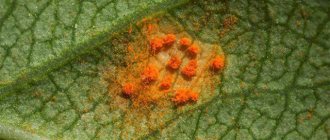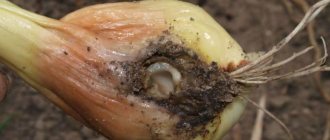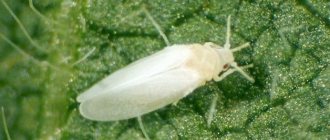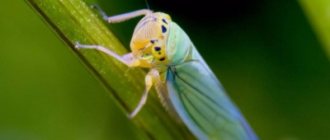For many years now, in the Kuban, the white leafhopper (Metcalfa pruinosa Say) has been spreading throughout our region on all plants. This is a very dangerous pest of the garden and vegetable garden, which feeds on the sap of plants, weakens them, destroying our harvest. The white leafhopper, the control measures against which seem to be not complicated, but can take a lot of time from gardeners. It is imperative to fight it, since, among other things, it spreads diseases from one plant to another.
White leafhopper, photo
Types of leafhoppers
These insects got their name because of their ability to chirp. I can’t imagine a summer evening in Kuban without the “singing” of cicadas. These loud “cicking” sounds are made by singing cicadas - rather large insects that look like flies with transparent wings stretched back. But this is only one type of cicada. There are roseate leafhoppers, they are much smaller.
Song cicada, photo
Rose leafhopper, photo
And we will talk about the white leafhopper, a relatively new pest for our region. The exact number of cicada species is unknown, but there may be more than 100,000 of them. So, insects with this name of different sizes and colors can be found on all continents.
For the first time I saw an adult white leafhopper on the Black Sea coast, in Lazarevskoye. On the way to the sea I saw a tall fig tree, at the foot of which there was a lot of growth. My attention was caught by the small white pimples on the young green stems. It seemed as if someone had deliberately dotted white droplets of paint on all the branches.
I touched one and... recoiled in surprise - a white elongated droplet suddenly either jumped or flew, sitting down on a fig leaf nearby.
But two weeks before, while still at home, at my dacha I noticed a white fluffy coating on the branches, leaves of raspberries and figs on various plants. I sent a photo to a gardener from Timashevsk - he enlightened me that this is a metcalfa - a white leafhopper.
It turns out that in my garden I saw white leafhopper larvae, and a little further south, on the Black Sea coast, I saw already adult pests.
Its invasion has threatened the entire Krasnodar region for the last 2-3 years. From information on the Internet, I learned that for the first time in our country, the white leafhopper (native North America) was discovered in 2009 in Lazarevskoye, where it was brought with seedlings, probably through the seaports of Yeisk and Novorossiysk.
I think that the measures to combat the white leafhopper that gardeners can use are not particularly capable of dramatically changing the situation. And now you will understand why.
Black-spotted cicada
This species of cicada lives everywhere, feeding on the juice of leaves of mint, sage, catnip and other plants. An adult individual has a body length of less than 4 mm, a dark color.
green or yellow. All parts of the body are marked with black or black-brown spots, the abdomen is black, the paws are yellow. The larva is yellow-green in color and has a flattened shape.
This type of cicada overwinters at the stage of eggs, which were laid by females in the remains of plants in mint fields. In the spring, with the onset of warm weather, at the end of April - the first half of May, larvae emerge from the eggs. In mid-May, they enter the pupal stage, or pamer, with the rudiments of wings and move to the fields of labiate plants.
At the end of July - beginning of August, during the period of bud setting, adult cicadas return to mint fields and cause great damage to the plants. The insect and its larvae suck the juice from mint leaves, causing them to become spotted, senescent, and prematurely drop. During the year, the cicada reproduces up to 4–5 times.
To protect against cicadas, mint is sown in fields remote from the places of previous crops; resistant varieties of mint are selected for sowing; When the pest multiplies strongly, spraying with insecticides is used.
Which plants can be harmed by the white leafhopper?
If I now begin to list which plants this pest is dangerous to, the list will turn out to be very long - there are more than 300 of them. What does the pest prefer most? These are boxwood, linden, maple, rose hips, apple trees, plums, grapes, raspberries, gooseberries, figs, potatoes, carrots, peppers, tomatoes, corn, and many others.
Will gardeners be able to apply measures to combat white leafhopper on all plants? Of course not!
The main damage to garden and garden plants is caused by larvae, piercing the leaves with their proboscis on the underside and sucking out the juice. This leads to the appearance of small white or yellow dots on the top of the leaves, which sometimes merge into large whitish spots. The immunity of plants decreases, they become weak, their growth slows down, fruits may fall from the tree without ripeness or not form at all.
On tomatoes, the pest lays eggs at the bottom of the trunk, just above the ground. You won't notice it right away. The same goes for celery, parsley, eggplant, and bell pepper. But if left untreated, the larvae will begin to suck the juice from the trunks of vegetable plants. Raspberries, blackberries, and figs lose their attractive appearance after its appearance. On my dogwood I notice larvae on the back of the leaves and on the stalks of the berries.
The appearance of plants is lost due to the sticky secretions of the leafhopper. Why is this dangerous? So-called sooty fungi develop on them. And this is already a source of fungal diseases. Some sources cite the cause of the appearance of sticky spots as plant sap, which begins to drip intensively onto the leaves as a result of the leafhopper actively feeding. Whether this is true or not, I don’t know. But a spoiled appearance can still be survived, but fungal diseases are a terrible enemy of our gardens and vegetable gardens.
Six-spotted cicada
This species of cicada lives everywhere and has a body no more than 3–4 mm long. The head is yellow-green with
clear black spots.
Eggs laid by cicadas in the leaf tissue of cereal crops survive the winter and spring in the last ten days of April; in the first days of May, brown larvae emerge from them. Later they acquire the color of an adult insect. The larvae mature in 20–30 days.
Over the summer period, up to three generations of six-spotted cicadas develop. In the autumn months, the cicada makes its last clutch of eggs on winter plantings or carrion. These eggs overwinter until spring, and the growing cycle repeats again.
Adults and larvae feed on juice from leaves of wheat, rye, oats, corn, rice, millet, buckwheat, sunflower, beets, and legumes. They greatly harm agricultural crops, as plants damaged by cicadas wither, become discolored, weaken and die.
In order to protect cereal plantations from cicadas, the destruction of cereal carrion is practiced, since the cicada lays eggs in it, from which new generations of insect pests emerge in the spring.
For the same purpose, they try to sow winter crops as late as possible, and spring crops as early as possible. This makes it impossible for the insect to lay eggs in them. If pests multiply too much, young shoots of winter crops are sprayed with insecticides.
Timing of treatments
The white leafhopper develops from May to August. But in more southern areas, adult insects can be observed as early as mid-July. It is the period from the moment the larva appears until the formation of an adult that preventive and protective measures are most effective.
In July-August, when there are already adult leafhoppers on the branches of plants, laying eggs, ready for overwintering, no control measures will bring the desired result. It is best to treat the plants when you notice a white fluffy coating on them - these are the larvae of the pest, and they are the ones that must be primarily dealt with.
Dark cicada
This species is distinguished by a black-brown body in the female and yellow-orange in the male, size - no more than 4 mm. The head has 2 black stripes between the eyes, the proboscis is long, pointed at the end.
The wings are transparent; on the underside of the front wings of females there is a brown spot; in males they are half smoky, sometimes shortened. The hind legs are movable.
In the spring, with the onset of warm weather, females lay several eggs in the tissue of old basal leaves. After this, the insect dies. The eggs take 30–35 days to develop. Before molting, the larvae are yellowish with gray stripes along the abdomen; after two moults they become gray-brown.
The larvae live on the lower leaves of the plant, sucking the juice from them. They overwinter in the upper layers of the soil. More mature larvae that have survived the winter move closer to the top of the plant. At the end of April - in the first half of May, the adult individual fledges; throughout the summer and until the end of autumn, both larvae and adult insects can be found in the fields; the boundary between these stages of cicada development is blurred.
After winter crops emerge, cicadas fly to these fields, feed on the sap of cereal plants and harm young shoots of cereals. This species is dangerous as a carrier of cereal plant disease viruses.
Traditional methods
When using a chemical control method, it should be remembered that some plants are sensitive to certain drugs. Also, if the same chemical is used frequently (eg Derris).
It is necessary that the new chemical also contain a new active component. The opinion that this is true is also incorrect. that natural products are less toxic than synthetic ones. Any chemical used against aphids will be effective against leafhoppers.
Plants are treated in inclement weather, when adult insects are least active. In this case, the jet of the drug is directed to the lower surface of the leaves. Fumigation bombs, which are used indoors, are also suitable for controlling this pest.
In May-June, the first generation of rose leafhoppers is treated with a systemic insecticide. You can repeat the procedure after some time. during the period of active growth of green pets. Contact insecticides should be used more often than systemic insecticides, since they only affect the insect through direct contact with it.
Collection and disposal of damaged parts of crops (they contain larvae). In this case, combustion will be most effective.
Digging the soil after the autumn harvest. This will help bring egg clutches and larvae of insects that have settled in for the winter to the surface of the soil. Frost and hungry birds will do the rest.
Bird feeders, birdhouses, and houses will help attract birds to your property, and birds are the worst enemies of leafhoppers.
The areas of vegetable gardens and orchards that have been attacked by cicadas should be left fallow for several seasons. It’s great if you can plant the area with onions or garlic.
And one more important rule: no weeds! All parasitic plants must be destroyed on the vine, especially during the breeding season of the pest.
The most popular way to combat cicadas is to use a soap solution based on laundry soap (300 g/10 l). Two or three sprays are enough to get rid of the pest.
Garlic or onion tincture (250 g/1 l), infused for a week in a sealed form, also works well as a fight. The finished mixture is diluted in a ratio of 1:50 and sprayed on the affected plants. Repeat the procedure several times.
Among the advice of folk wisdom there are recipes for combating rose pests. You need to choose a product depending on the gardener’s capabilities and the extent of the leafhopper’s spread in the area.
| Folk recipe | Rules for preparation and use |
| Tar soap | 300 grams of tar soap dissolves in 10 liters of warm water. Spray roses 3 times a week. Processing time May-June. |
| Infusion of garlic or onion | Chop 250 grams of onion or garlic and add 1 liter of clean water. Place in a closed container. Leave for a week. Dilute the infusion in a ratio of 1:50 with water and water the infected plants. Spray roses with the same composition 3-4 times with an interval of 7 days. |
| Infusion of chamomile. | Leave 1 kg of inflorescences in a bucket of hot water for 12 hours. Dilute the prepared infusion with water in a ratio of 1:3 and add 40 grams of soap shavings. Spray the plants at intervals of 5-7 days. |
| Infusion of horse sorrel root. | Pour 200 grams of crushed root into a bucket of warm, clean water. Leave for 2 hours and strain. Squeeze the roots further. Add 40 grams of laundry soap shavings. Spray the roses. |
The harmfulness of insects
The damage caused by cicadas to plants is as follows:
- sucks juice from plants, which destroys young shoots;
- trims tender shoots with an ovipositor;
- is a carrier of viral diseases.
Despite their small size, cicadas cause significant damage to agricultural crops.
Root aphids are one of the most dangerous pests, as they settle in the roots of plants. Read here how to fight this insect.
If you love beets, then you definitely need to know how to deal with insect pests, which also do not mind eating this plant. Read more at https://stopvreditel.ru/rastenij/selxoz/vrediteli-svekly.html link.
Effective drugs
Preventive measures do not always give a positive result, so special preparations designed specifically to kill pests come to the rescue. Such drugs include insecticides such as, for example:
- Calypso;
- Confidor;
- Aktara;
- Akarin;
- Proteus;
- Vizcaya;
- Decis.
Spraying of plants damaged by cicadas with preparations must be carried out 2-3 times, with an interval of 10 days.
Usually, after the second 12/11/2018 at 22:11
The whole yard is full of deep cicada holes, what should I do?
If prevention does not give the expected result, then insecticides cannot be avoided.
The procedure is carried out in calm weather at sunset. in the absence of wind precipitation.
It is necessary to spray the inner leaf plate, since the young growth of the pest is located in these places.
The sprayer must have a diffuser type nozzle so that fine irrigation will abundantly and evenly cover the entire area of the plant.
Prepare the solution only before processing and do not store it “for reserve”.
Aktara
Vizcaya
Calypso
Proteus and others.
The crops need to be processed twice or thrice, with an interval of 1.5 weeks. Typically, two times is enough to achieve maximum success.
When choosing a chemical, first of all pay attention to its active ingredient, which is usually indicated on the packaging. Manufacturers often change the names of their products, but the main substance usually remains the same.
Active components that affect insects upon direct contact include nicotine, malathion (crassula, ferns, gerberas, orchids and pylene cannot tolerate it), as well as pyrethroid.
biore smetry. Time-released active ingredients include lindane. which should not be used in relation to fruit crops due to the high toxicity of this substance, as well as pirnmpfos-metpl.
include dimethoate (it is not used for the treatment of cineraria, chrysanthemums, cyclamen, hydrangeas, ferns, begonias, fuchsias, ninsetts). To choose the most effective drug, you need to carefully study the instructions and determine how suitable it is for a particular situation.
Please note the following points:
- It is necessary to select a control agent depending on the degree of damage to the bushes.
- Any treatment must be repeated at intervals of no more than 14 days.
- When spraying, the drug should fall on the lower part of the leaf.
- Not only the plant is treated, but also the area adjacent to the bush.
- The packaging of the drug must contain all the required details, otherwise it may be a fake.
Prevention
The most effective prevention is competent agricultural technology. Take the time to thoroughly study everything about the necessary conditions for plants in your garden, flower bed and vegetable garden. Look after them accordingly.
Prevent weeds from growing and moisture from accumulating. Thin vegetable crops on time. In the fall, harvest not only the crop, but also the tops and fallen leaves, and regularly clean the trees of old and dead parts.
Periodically organize garlic-soap irrigation. Some gardeners share their experience of preventative spraying of garden specimens with Ditox, Danadim, Tagore, Tzipi plus. The procedure must be done before the buds open and repeated somewhere in the second ten days of May, when the moth larvae appear.
The leafhopper is very difficult to remove, so do not count on instant results after the first sprinkling. The final result will require long-term hard work over several years.
Tags: fight, dacha, leafhopper
About the author: admin4ik
« Previous entry











